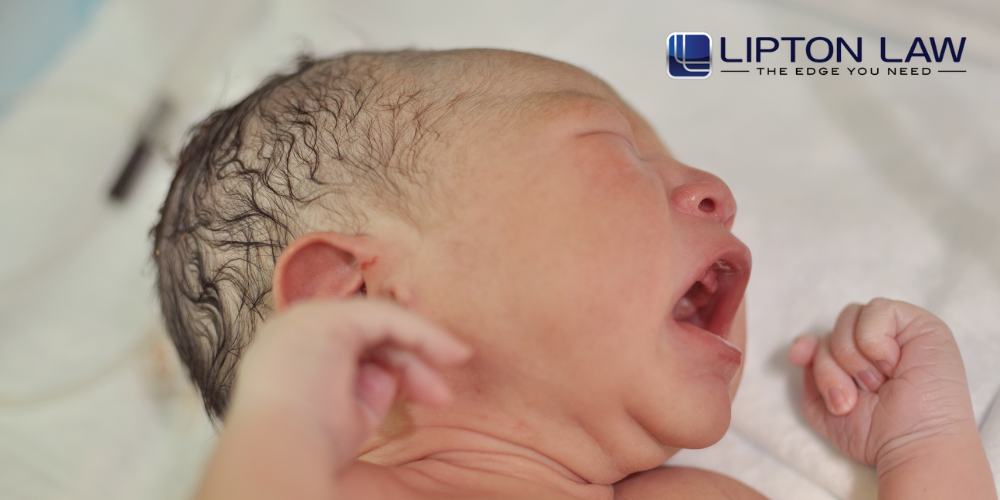Michigan Brachial Plexus Injury Lawyer
Home » Southfield, Michigan Medical Malpractice Lawyer » Brachial Plexus Injury
Dedicated Southfield, MI Brachial Plexus Injury Attorneys
If your newborn struggles to move one arm or reacts differently to touch on one side, it may signal a birth injury that needs prompt attention. Lipton Law can explain your options, answer your questions, and help you understand whether an experienced Michigan brachial plexus injury lawyer on our team can assist your family.
Births are meant to be joyous occasions. However, medical errors can cause injuries that severely impact your child’s life. At Lipton Law, we understand how devastating this experience can be. Our Michigan birth injury lawyers assist local families in pursuing compensation from negligent healthcare providers.
Don’t wait to secure legal counsel for your child’s birth injury case. Call Lipton Law at (248) 557-1688 to schedule your free consultation today.
What is the Brachial Plexus?
The brachial plexus is a nerve bundle located in your shoulder. This bundle sends signals between your spinal cord and your arm. Brachial plexus nerves control movement and sensation in your wrists, hands, and arms. Damage to these nerves can severely impact movement at your shoulder, elbow, wrists, or fingers. Additionally, brachial plexus nerve damage can limit your ability to feel sensations, such as pain or temperature, in those areas.
Brachial Plexus Nerves
Five major branches of nerves extend down the arm from the brachial plexus nerve bundle. Each affects specific movements and sensations.
The Musculocutaneous nerve allows you to flex the upper arm muscles in the shoulder and elbow. The Axillary nerve aids shoulder rotation and helps you lift your arm away from the body. The Median nerve moves the forearm and parts of your hand. The Radial nerve is connected to muscles throughout the limb, including those in the upper arm, elbow, forearm, and hand. The Ulnar nerve helps with fine motor control in your fingers.

Types of Brachial Plexus Injuries at Birth
When a baby’s brachial plexus nerve bundle is injured during birth, it is referred to as an obstetric brachial plexus injury. According to research shared by the National Institutes of Health, obstetric brachial plexus injuries occur in approximately 1 to 3 births per 1000. Generally, these injuries are categorized as either an Erb’s palsy injury or a Klumpke’s palsy injury.
Erb’s Palsy
Erb’s palsy involves damage to the upper brachial plexus. This is the most common type of brachial plexus injury at birth, affecting motion and sensation in the shoulder, arm, and elbow.
Klumpke’s Palsy
Klumpke’s palsy is rarer and involves damage to the lower brachial plexus nerves. In this case, the injury impacts movement and feeling in the wrist, hand, and fingers.
Brachial Plexus Injury Symptoms
Symptoms vary depending on the location and severity of the injury. In most cases, such injuries will impact the baby’s muscle function and physical sensation. Severe injuries can result in paralysis of the hand or arm.
Erb’s palsy affects the upper portion of the brachial plexus. Common symptoms include numbness in the shoulder, loss of shoulder motion, and an inability to flex the elbow. Infants with this injury may be unable to lift their arms or bring objects to their mouths. If your child keeps their arm in an odd position, they may have sustained an Erb’s palsy injury.
Klumpke’s palsy impacts the lower part of the brachial plexus. Symptoms include loss of motion or sensation in the baby’s wrist, hand, or fingers. A weak grip may indicate that your child has a brachial plexus injury.
If you notice any of these symptoms, consult a doctor as soon as possible. A medical professional can determine the cause of your baby’s symptoms through careful observations and tests. Magnetic Resonance Imaging (MRI) tests create a magnetic field by using radio waves. This allows doctors to examine the brachial plexus area. Alternatively, doctors may use a Computerized Tomography (CT) scan to examine for damage. Before the test, doctors may inject contrast material to make the nerves more visible on the results.

Brachial Plexus Injury Treatment
Children with mild injuries may recover without treatment. However, babies often require occupational or physical therapy to recover from a brachial plexus injury. A medical professional will show you massage, stretching, and exercise techniques you can use at home to help your child heal. More serious injuries may require surgery. This can involve nerve grafts, nerve transfers, muscle transfers, or tendon transfers.
How A Newborn Can Sustain a Brachial Plexus Injury at Birth
Multiple factors can contribute to an increased risk of brachial plexus injury at birth. Oftentimes, doctors can prevent birth injuries by offering proper medical care. Your doctor should take the utmost care during your delivery. This includes safely using tools and birthing techniques, monitoring for potential issues, and acting accordingly to avoid or mitigate risks associated with birth injuries.
It is sometimes difficult to deliver large babies. If their shoulders are too broad to fit through the birth canal easily, the baby’s head may stretch away from their shoulder. This can injure the brachial plexus. Additionally, any complication that causes a prolonged or difficult labor can increase the risk of injury. Babies of diabetic mothers are also more prone to brachial plexus birth injuries. In such cases, a doctor may recommend a C-section to avoid injuries.
Proper positioning is important for a safe vaginal birth. Ideally, the baby should be positioned to exit the birth canal headfirst. Abnormal positions pose risks, including oxygen deprivation and various birth injuries. Doctors should monitor for improper positions, such as if the baby is positioned to come out feet-first or facing forward. Odd positioning can make a C-section a safer option.
Shoulder dystocia can also cause brachial plexus injuries at birth. This happens during vaginal birth when the baby’s shoulder becomes stuck behind the mother’s pubic bone. A “turtle sign” can indicate that shoulder dystocia has occurred. This is when the baby’s head is delivered, but the baby pulls back into the birth canal. The medical team should then work to dislodge the baby’s shoulder promptly. Lipton Law’s Michigan shoulder dystocia lawyers help local mothers whose babies suffered injury due to shoulder dystocia.
Doctors may cause brachial plexus injuries by poorly using specific tools or techniques. When used improperly, forceps and vacuum extractors can cause severe spinal cord injuries or brain injuries. Additionally, manual manipulation of the infant during the birthing process can stretch the brachial plexus and injure it.

Long-Term Effects of a Brachial Plexus Injury
Long-term effects can differ from one case to the next. Severe injuries are more likely to result in chronic health issues. However, timely diagnosis and proper treatment can mitigate the risks of long-term issues. Below are some of the long-term effects associated with brachial plexus birth injuries.
Severe or Chronic Pain:
Nerve damage can lead to a wide range of conditions that cause chronic pain. For example, some children with brachial plexus injuries experience chronic muscle tightness that can cause significant pain.
Muscle Issues:
Some children experience muscle weakness, involuntary spasms, and muscle atrophy. These issues can severely impact movement, dexterity, and strength.
Loss of Sensation:
Loss of sensation can be especially dangerous for infants, as they lack the sensory input necessary to be aware of cuts, burns, or other skin injuries.
Paralysis:
In some cases, brachial plexus injuries can lead to total paralysis of the arm, wrist, or hand.
Limb Growth:
The affected arm may grow more slowly, resulting in a noticeable difference between the length of each arm.
Poor Balance or Coordination:
Children who experience impaired sensation, muscle movement, or strength on one side are more likely to have trouble with balance and coordination.
Osteoarthritis:
Children with brachial plexus injuries can develop painful Osteoarthritis in the shoulder.
Horner's Syndrome:
This neurological condition affects communication between the brain and eyes. Horner’s syndrome can result in constricted pupils or drooping eyelids on one side of the face.
Scoliosis:
Imbalanced muscular strength may put uneven pressure on your child’s spine as they grow, potentially leading to the development of scoliosis.
Mental Health Issues:
Children with physical disabilities may struggle more to fit in. This can result in depression and self-esteem issues.
How an Experienced MI Birth Injury Lawyer Can Help
Pursuing legal action against a medical professional can be difficult. They will do everything in their power to protect their reputation and finances. Doctors can rely on their medical knowledge to defend themselves. Additionally, the defendant’s attorney will use their legal experience to undermine your case. Without legal support, Michigan families are at a disadvantage.
Fortunately, legislators recognize that medical malpractice is a major concern among patients. At both the state and federal levels, our lawmakers have taken measures to protect patients. If your infant has sustained injuries due to medical negligence or malpractice, consult with a Michigan birth injury lawyer as soon as possible.
An experienced birth injury lawyer has the legal knowledge and experience necessary to level the playing field. Local attorneys will hold physicians, doctors, and healthcare providers responsible for preventable birth injuries. Although nothing can undo the stress and turmoil your family has gone through, your legal representation can help you get the compensation you need to give your child the best chance at recovery.

How to Prove Malpractice in a Brachial Plexus Birth Injury Lawsuit
Your attorney may employ several extremely reliable legal strategies to prove medical malpractice.
Medical records can play an important role in birth injury cases. For example, babies of diabetic mothers are more at risk for brachial plexus injuries. Similarly, mothers who previously experienced shoulder dystocia in birth are more likely to experience it in subsequent births. If the mother’s medical history indicates that the baby was at increased risk for injury, your lawyer may argue that the doctor did not take sufficient action to prevent the injury.
Test results also provide significant evidence in birth injury cases. Your lawyer can have the results of CT scans or MRI tests brought in to prove the injury exists. Lawyers sometimes work with medical professionals to explain such test results to a jury.
Witness testimony is another legal strategy that can help prove malpractice. This may involve seeking the opinions of experts in a particular medical field or securing testimony from the doctors who diagnosed or treated your child’s condition. Perhaps most importantly, lawyers can request witness statements from individuals who were present during the birth. You may be asked to share your firsthand experiences of the birth. Alternatively, doctors or nurses who were in the room may confirm that the doctor was having difficulty delivering.
Brachial Plexus Injury Case Statute of Limitations in Michigan
Families filing birth injury lawsuits must do so within the statute of limitations for medical malpractice in Michigan. These cases must be filed on the later of two possible dates: either within two years from when the malpractice occurred or within six months of when the medical error was discovered/should have been found.

Why Choose Lipton Law For Your Brachial Plexus Injury Claim
The legal professionals at Lipton Law understand how birth injury cases affect local families. Our Michigan medical malpractice attorneys value our clients’ well-being. We prioritize compassion and empathy while aggressively protecting your rights. With over 30 years of experience in medical malpractice cases, our team provides critical guidance throughout your case.
Lipton Law has a proven track record of helping victims of medical malpractice and medical negligence. We will build strong cases based on a thorough understanding of Michigan laws and substantial experience with local courts. Our team aims to help you secure significant punitive damages to cover the cost of physical therapy, surgical intervention, ongoing treatments, disability accommodations, and more.
Lipton Law’s Unique Medical Malpractice Team
Lipton Law further enables our attorneys to hold medical professionals accountable by investing in the ongoing education and development of our team. Our Michigan birth injury lawyers stay informed on all the latest in medical practices and legal regulations.
We also employ multiple nurses who closely examine and review every medical malpractice case our lawyers take on. They provide insight into medical details, help our lawyers understand test results, and aid us in building strong cases for our clients.

Contact the Southfield Brachial Plexus Injury Attorneys at Lipton Law Today For a Free Consultation
If a doctor’s negligence has injured your baby, don’t wait to call Lipton Law. The sooner you call, the sooner we can help you seek the compensation you are owed. Our law firm offers experienced and reliable legal support to families in Michigan. With decades of experience in medical malpractice, we fight diligently on behalf of you and your child.
Allow the Lipton Law team to help your child secure a path to recovery. Call (248) 557-1688 or reach out online to schedule your free consultation with a birth injury lawyer in Michigan.
Types of Medical Malpractice
Practice Areas

